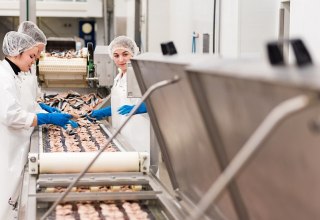The art museum in the Kunstmühle dedicates its exhibition and collection activities to the painters of the Schwaan artists' colony. In addition to its own collection, changing exhibitions are shown. These tie in with the works of the Schwaan painters and place them in a new context.
The former mill house was built about 200 years ago on the river Beke and is one of the oldest preserved secular buildings in the city. The beam and half-timbered construction of the former mill was carefully integrated into the gallery rooms. On the first floor there is a historical mill room. In the course of the emergence of numerous artist colonies in Europe, a community of painters also emerged in Schwaan around 1880/85. Schwaan natives Franz Bunke, Rudolf Bartels, Peter Paul Draewing and Alfred Heinsohn from Hamburg were the main pillars of the only Mecklenburg artists' colony. They studied landscape painting under a realistic view of nature at the Weimar School of Painting and pursued their nature studies in their Mecklenburg homeland. The painter and professor Franz Bunke is credited with the breakthrough of open-air painting in Mecklenburg. Rudolf Bartels and Alfred Heinsohn increasingly approached modern to abstract painting in their works. Through his approaches to modernism, Rudolf Bartels became the most important artist in Mecklenburg in the first half of the 20th century.
The town's art museum is dedicated to the painters of its artists' colony Schwaan. The exhibition rooms are located in the old water mill, which was built around 1790 by order of the Duke of Mecklenburg. It is one of the oldest preserved secular buildings. The building with its half-timbered construction was opened as an art museum 20 years ago. It displays Mecklenburg painting on three floors, focusing on the artists' colony of Schwaan in the 19th and 20th centuries. A series of expressive landscapes, showing a sense of the temperate colors of nature, provide insights into the history of the colonists. They establish connections with other great landscape painters of our country. Changing exhibitions are devoted in particular to the theme of "Artists' Colonies in Europe" and put them in a new context.
Accessibility information
- There is a parking lot of 4,40 m x 5 m available for people with disabilities. This is located 60 m from the entrance.
- The path from the parking lot to the entrance is easy to walk and drive on, except for a small section (cobblestones). It has a gradient of 6% over a distance of 14 meters.
- The destination of the path is usually within sight or there are path signs at a constantly visible distance.
- Access to the building is step-free (door threshold 1 cm).
- All rooms usable by guests and elevated are accessible at ground level or by elevator.
- The elevator car is 109 cm x 140 cm (width x depth). The command devices are placed at a height of 105 cm to 117 cm.
- All passageways/doors are at least 90 cm wide.
- The information counter/cash register is 92 cm high. There is an alternative communication option while seated.
- The exhibits are mainly visible while standing or sitting.
- Guided tours are available for people with walking disabilities and wheelchair users. Tour guides are trained so that guests with walking disabilities and wheelchair users can participate in any tour and their concerns are addressed.
- Mobile or fixed seating is available for people with walking disabilities to use during the tour.
- Assistance dogs may be brought along.
- A public restroom for people with disabilities is available.
- The movement areas are:
- 111 cm x 70 cm to the left of the WC, 80 cm x 70 cm to the right;
- in front of the WC, the sink and the door at least 138 cm x 170 cm.
- There are fold-up grab rails on both sides of the WC.
- The washbasin can be moved underneath and the mirror can be viewed while standing or sitting.
- There is an alarm trigger (alarm button, cord).























